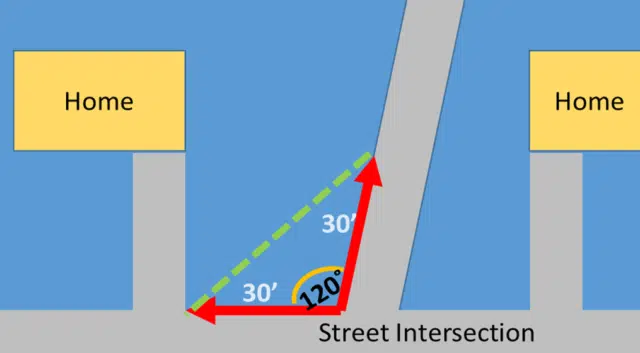Do you know Fairfax County’s rules for fences? On residential lots, regulations may differ based on various factors, but a commonly chosen fence height in Fairfax County is either 4 feet or 6 feet. Generally:
- All fences must comply with Article 4 of the Zoning Ordinance, which regulates their location and height.
Front Yard Regulations:
- A fence cannot exceed four feet in height, except:
- On lots of two or more acres in the R-A through R-1 Districts, up to seven feet in height is permitted in any yard.
- With Board of Zoning Appeals approval of a special permit application, the maximum permitted front yard fence height may be increased up to six feet.
- On corner lots, there are two or more front yards, in which fences cannot exceed four feet in height, except as provided above.
Side and Rear Yard Regulations:
- A fence is limited to seven feet in height, except:
A solid wood fence located flush to the ground may be up to eight feet in height in the rear yard that abuts a major thoroughfare, or where a side or rear lot line is within 150 feet of a major thoroughfare and abuts common or
dedicated open space located between the lot and the major thoroughfare.
Lot and Yard Determinations


Do we need a permit for a fence in Fairfax county?
- Building Permits are not typically required for fences of any height in Fairfax county, however, city of Vienna and city of Falls Church require a zoning permit.
Additional Information:
- Corner Lots: Properties located on corner lots might have additional restrictions to ensure visibility for traffic at intersections. These fences may need to be lower or set back further from the street.
- Material Restrictions: Some regulations might specify the types of materials that can be used for fencing, especially in historic districts or neighborhoods with specific aesthetic guidelines.
- HOA Rules: Homeowners associations can impose their own rules, which might be more restrictive than local zoning laws. These rules can cover height, material, color, and style of fences.
- Shared Fences: If a fence is shared between two properties, both property owners usually must agree on the height and other aspects of the fence.
- Special Regulations: There may be special regulations for fences around pools, which typically need to meet specific safety standards, such as being at least four feet high and having a self-closing, self-latching gate.
Zoning Ordinance guidelines in Fairfax County for fence height:
Maximum Allowed Fence or Wall Height in Fairfax County, VA; Table 4102.4: From zoning ordinance
| Yard Where Fence or Wall Located | Location, Size, or Use of Lot | Material Fence or Wall Composed of | Maximum Allowed Height of Fence or Wall (ft.) |
Front, Side, or Rear | Lot of 2 or more acres located in R-A, R-C, R-E, or R-1 Districts | No requirement | 7 |
| Any Industrial use | No requirement | 7 | |
| All uses | No requirement | 4 | |
| Front | Residential corner lot that abuts a major thoroughfare [1] | Solid wood or masonry located flush to the ground | 8 |
| Side or Rear | Reverse frontage lot [2] or where the side or rear lot line is within 150 feet of a major thoroughfare and abuts common or dedicated open space located between the lot and the major thoroughfare | Solid wood or masonry located flush to the ground | 8 |
| Notes: | |||
| [1] The driveway entrance to the lot must be from a street other than the major thoroughfare, and the principal entrance of the dwelling must face a street other than the major thoroughfare. Additionally, the lot must not be contiguous to a lot which has its only driveway entrance from the major thoroughfare or service drive adjacent to the major thoroughfare. The fence may not extend into the front yard between the dwelling and a street other than the major thoroughfare. | |||
| [2] The Director may approve a privacy fence or wall if it does not obstruct the view of traffic from an intersecting street and maintains the minimum sight distance acceptable to the Virginia Department of Transportation for the permitting of entrances onto a thoroughfare of the class involved. | |||
Fairfax County Fence Regulations for Corner Lots (Front Yard ONLY)
If you’re considering installing a fence in Fairfax County, particularly on a corner lot, it’s essential to comply with local regulations. For front yard fences:
- Maximum Fence Height: Fences can be up to 48 inches (4 feet) tall.
- Sight Distance Triangle Restrictions: Within the sight distance triangle—a designated area near intersections to ensure visibility—the maximum fence height is limited to 42 inches (3.5 feet) to maintain safety for drivers, pedestrians, and cyclists.
- For a street corner with an interior angle of 90 degrees or more, points must be set 30 feet from the extended property lines (see Figure 1).
- For an interior angle less than 90 degrees, add 1 foot for every 10 degrees (or fraction) below 90.
- Example: A 75-degree angle rounds to 80 degrees, so points are set at 31 feet. A 74-degree angle rounds to 70 degrees, setting points at 32 feet.

To determine the specific fence height regulations for your area, you should:
- Check Local Zoning Codes: Visit your city or county’s official website or planning department to find zoning codes and ordinances.
- Consult Your HOA: If you live in a community with an HOA, review their guidelines.
- Seek Professional Advices Super Fabrications
